Assessing the Limits of Sustainable Agriculture Intensification Using a Spatial Model Framework †
Abstract
1. Introduction
2. Materials and Methods
2.1. General Framework and Land Suitability Analysis
2.2. Model Variables
2.3. Model Setup
- There is a need to move to a dynamic model to identify suitable pathways for achieving goals. It must consider a wider range of productive, economic, environmental, and climate change scenarios to provide improved probabilistic sensitivity analysis.
- Although the study considered technological improvements in some scenarios (genetic growth trend, new management practices), it did not include associated incremental costs in the model. That is, the same operative costs were assumed for all locations and scenarios. The only distinction in costs was made regarding logistics, transportation costs, and land tenure (rent).
- The logistics variables are being improved by incorporating new information, such as storage capacity, road and railroad infrastructure, and cultural aspects of farmers.
- The final area estimated by the model, after imposing all the restrictions, considered null and positive economic margins (≥0). This implies some overestimation as farmers may require a minimum non-zero positive margin, at least equivalent to the foregone benefits from other productive land uses.
- The rating scores used to weight the soil indicators were subject to expert opinion offered by specialists in the field. However, they exhibited a high degree of consistency and homogeneity.
- There were some highly productive areas in relatively isolated places, where logistics are scarce or difficult to develop. Those areas are visualized as scattered points in the GIS; quantifying these areas involves some difficulties due to their size and distribution. For that reason, they were not excluded from potential cropping land in this study if crop margins were positive.
- Although the model conceptually follows the steps shown in Figure 1, we obtained the final area by over-imposing the independently estimated restriction maps.
3. Results and Discussion
3.1. Land Suitability Analysis and Potential Yields
3.2. Erosion and Other Land Use Restrictions
3.3. Expected Economic Margins
3.4. Projected Scenarios
- Scenario 1: USD 310/MT—no technological change;
- Scenario 2: USD 350/MT—no technological change;
- Scenario 3: USD 400/MT—no technological change;
- Scenario 4: USD 310/MT—with technological change;
- Scenario 5: USD 350/MT—with technological change;
- Scenario 6: USD 400/MT—with technological change.
4. Conclusions
Author Contributions
Funding
Institutional Review Board Statement
Informed Consent Statement
Data Availability Statement
Acknowledgments
Conflicts of Interest
Abbreviations
| BAU | Business As Usual |
| CCSM4 | Community Climate System Model version 4 |
| COU | Conglomerado Oleaginosos Uruguay |
| FAO | Food and Agriculture Organization of the United Nations |
| GDP | Gross Domestic Product |
| GIS | Geographic Information System |
| GM | Genetically Modified |
| INIA | Instituto Nacional de Investigación Agropecuaria, Uruguay |
| LSA | Land Suitability Analysis |
| MGAP | Ministerio de Ganadería, Agricultura y Pesca, Uruguay |
| MT | Metric Ton |
| MTO | Mesa Tecnológica de Oleaginosos |
| PUMS | Plan de Uso y Manejo Responsable de Suelos |
| RCP | Representative Concentration Pathway |
| SDG | Sustainable Development Goals |
| SIGRAS | Sistema de Información Geográfica web, Unidad de Agroclima y Sistemas de Información (GRAS) de INIA |
| UN | United Nations |
| USLE | Universal Soil Loss Equation |
| USA | United States of America |
| USD | US Dollar |
References
- PS&D Online. Custom Query. United States Department of Agriculture, Foreign Agricultural Service. Available online: https://apps.fas.usda.gov/psdonline/app/index.html#/app/advQuery (accessed on 20 May 2025).
- Ritchie, H. Drivers of Deforestation. Published Online at OurWorldinData.org. Available online: https://ourworldindata.org/drivers-of-deforestation (accessed on 20 May 2025).
- FAOSTAT. Crops and Livestock Products. Food and Agriculture Organization of the United Nations. Available online: https://www.fao.org/faostat/en/#data/ (accessed on 20 May 2025).
- Hill, M.; Clérici, C. Planes de uso y manejo de suelos. Rev. Inst. Nac. Investig. Agropecu. 2011, 26, 65–69. Available online: https://www.inia.uy/sites/default/files/publications/2024-06/revista-INIA-26.pdf (accessed on 15 March 2025).
- Hopkins, M. Uruguay: Soybeans up on Argentine Investments. Published Online on 29 April 2008 at AgriBusiness GLOBAL. Available online: https://www.agribusinessglobal.com/markets/uruguay-soybeans-up-on-argentine-investments/ (accessed on 30 June 2025).
- de Ganadería, M.; Pesca, A.Y. Anuario Estadístico Agropecuario 2024. Available online: https://www.gub.uy/ministerio-ganaderia-agricultura-pesca/diea/anuario2024 (accessed on 20 May 2025).
- LatAm, D.D. Make Global Trade Data. Available online: https://www.datamyne.com/ (accessed on 20 May 2025).
- Ferraro, B.; Rava, C.; Borges, M.; Fernández, E.; Lanfranco, B. El complejo oleaginoso en Uruguay: Análisis zafra 2020/2021 y perspectivas. In Proceedings of the 10° Encuentro Nacional de la Mesa Tecnológica de Oleaginosos, Montevideo, Uruguay, 25 November 2021. [Google Scholar]
- Fernández, E.; Rava, C.; Borges, M.; Ferraro, B.; Lanfranco, B. El complejo oleaginoso en Uruguay: Análisis zafra 2021/2022 y perspectivas. In Proceedings of the 11° Encuentro Nacional de la Mesa Tecnológica de Oleaginosos, Montevideo, Uruguay, 13 October 2022. [Google Scholar]
- WWF. El Crecimiento de la Soja: Impactos y Soluciones; World Wide Fund for Nature: Gland, Switzerland, 2014. [Google Scholar]
- Dossa, D.; Chia, E. Cambio técnico y desarrollo económico: El caso de la cultura de soya en Brasil. In Agriculturas y Campesinados de América Latina: Mutaciones y Recomposiciones, 1st ed.; Linck, T., Ed.; Institut Français de Recherche Scientifique pour le Développement en Coopération, Fondo de Cultura Económica: Ciudad de México, México, 1994; pp. 105–115. (In Spanish) [Google Scholar]
- Seguy, L.; Bouzinac, S. Fronteras agrícolas del oeste de Brasil. Agric. Dev. 1994, 54–57. Available online: https://agritrop.cirad.fr/387437/1/document_387437.pdf (accessed on 15 May 2025).
- Conte, A.S. Expansión territorial del cultivo de soja en Argentina. In Proceedings of the I Jornadas de Geografía de la UNLP, Universidad Nacional de La Plata, La Plata, Argentina, 12–15 October 1993; pp. 315–331. [Google Scholar]
- LART-FAUBA. Patrones espaciales y temporales de la expansión de soja en Argentina. In Relación con Factores Socioeconómicos y Ambientales; Laboratorio de Análisis regional y Teledetección, Facultad de Agronomía, Universidad de Buenos Aires: Buenos Aires, Argentina, 2004. [Google Scholar]
- Paruelo, J.M.; Guerschman, J.P.; Piñeiro, G.; Jobbágy, E.G.; Verón, S.R.; Baldi, G.; Baeza, S. Cambios en el uso de la tierra en Argentina y Uruguay: Marcos conceptuales para su análisis. Agrociencia 2006, 10, 47–61. [Google Scholar] [CrossRef]
- Castillo, P. Expansión regional del cultivo de soja en Argentina. Doc. CIEA 2007, N°3, 119–132. Available online: https://www.ciea.com.ar/web/wp-content/uploads/2016/11/Doc3_5.pdf (accessed on 1 June 2025).
- OEA. Evaluación Regional del Impacto en la Sostenibilidad de la Cadena Productiva de la Soja: Argentina, Uruguay y Paraguay; Organización de los Estados Americanos: Washington, DC, USA, 2009. [Google Scholar]
- Gibbs, H.K.; Rausch, L.L.; Munger, J.; Schelly, I.; Morton, D.C.; Noojipady, P.; Soares-Filho, B.; Barreto, P.; Micol, L.; Walker, N.F. Brazil’s soy moratorium: Supply chain governance is needed to avoid deforestation. Science 2015, 347, 377–378. [Google Scholar] [CrossRef]
- Páez, S.M. Soja en Argentina a principios del siglo XXI: El Sistema agropecuario y la competencia por el uso del suelo. Cuad. Econ. Crítica 2016, 3, 135–169. [Google Scholar]
- Pierri, J.; Wesz, V.J., Jr. La sojización en Argentina y Brasil (1984/2014): Influencia de las políticas públicas, de las empresas transnacionales y de la estructura económica dependiente. Extensão Rural 2017, 24, 20–41. [Google Scholar] [CrossRef]
- Rausch, L.L.; Gibbs, H.K.; Schelly, I.; Brandão, A., Jr.; Morton, D.C.; Carneiro Filho, A.; Strassburg, B.; Walker, N.F.; Noojipady, P.; Barreto, P.; et al. Soy expansion in Brazil’s Cerrado. Conserv. Lett. 2019, 12, e12671. [Google Scholar] [CrossRef]
- Gutiérrez, N.; Ferraro, B.; Patrouilleau, M.M.; Alonso, I.; Rodas, C.; Carrasco, J.; Cordeiro, L.A.M. Políticas públicas e institucionalidad para la intensificación sostenible en los países del Cono Sur. Programa Cooperativo para el Desarrollo Tecnológico Agroalimentario y Agroindustrial del Cono Sur (PROCISUR). 2020. Available online: http://www.iica.int (accessed on 1 July 2025).
- Strada, J.; Vila, I.A. La Producción de Soja en Argentina: Causas e Impactos de su Expansión. Centro Cultural de la Cooperación, 2022. Estudios de Economía Política y Sistema Mundial, Ed.: 23. Available online: https://www.centrocultural.coop/revista/23/la-produccion-de-soja-en-argentina-causas-e-impactos-de-su-expansion (accessed on 1 July 2025).
- UN Sustainable Development. The 17 Goals. United Nations Department of Economic and Social Affairs. Available online: https://sdgs.un.org/goals/goal2#targets_and_indicators (accessed on 1 June 2025).
- FAO. A Framework for Land Evaluation. FAO Soils Bulletin 1976, 32. Available online: https://www.fao.org/3/x5310e/x5310e00.htm (accessed on 30 November 2024).
- Faggian, R.; Johnson, M.M.; Sposito, V.; Romeijn, H. Climate Smart Agricultural Development Technical Report: Fruit Production; Deakin University, CeRRF: Melbourne, VIC, Australia, 2016. [Google Scholar]
- Duc, T.T. Using GIS and AHP Technique for Land-Use Suitability Analysis; International Symposium on Geoinformatics for Spatial Infrastructure Development in Earth and Allied Sciences: Ho Chi Min, Vietnam, 2006; Available online: https://www.geoinfo-lab.org/gisideas06/papers/USING%20GIS%20AND%20AHP%20TECHNIQUE%20FOR.pdf (accessed on 1 July 2025).
- Akinci, H.; Ozalp, A.Y.; Turgut, B. Agricultural land use suitability analysis using GIS and AHP technique. Comput. Electron. Agric. 2013, 97, 71–82. [Google Scholar] [CrossRef]
- Borges, M. Climate Change and Variability Impacts on Soybean Production in Uruguay. M. Science (Research) Thesis, School of Life and Environmental Sciences and Centre for Regional and Rural Futures, Deakin University. Available online: https://dro.deakin.edu.au/articles/thesis/Climate_change_and_variability_impacts_on_soybean_production_in_Uruguay/21113308?file=37457113 (accessed on 15 May 2025).
- SIGRAS. Sistema de Información Geográfica Web. Instituto Nacional de Investigación Agropecuaria, Unidad de Agro-Clima y Sistemas de Información (INIA-GRAS). Available online: https://inia.uy/sigras/ (accessed on 30 November 2024).
- Cal, A.; Giménez, A.; Tiscornia, G. Sistema de información geográfica web “SIGRAS”. Rev. Inst. Nac. Investig. Agropecu. 2013, 33, 66–69. [Google Scholar]
- Bachmann, N.; Tripath, S.; Brunner, M.; Jodlbauer, H. The contribution of data-driven technologies in achieving the Sustainable Development Goals. Sustainability 2022, 14, 2497. [Google Scholar] [CrossRef]
- Varotsos, C.A.; Cracknell, A.P. Contribution to the success of the Sustainable Development Goals—UN 2030 agenda. Remote Sens. Lett. 2020, 11, 715–719. [Google Scholar] [CrossRef]
- Kulmala, M.; Lintunen, A.; Ylivinkka, I.; Mukkala, J.; Rantanen, R.; Kujansuu, J.; Petäjä, T.; Lappalainen, H.K. Atmospheric and ecosystem big data providing key contributions in reaching United Nations’ Sustainable Development Goals. Big Earth Data 2021, 5, 277–305. [Google Scholar] [CrossRef]
- Rizzo, G. Estimación y Análisis Espaciotemporal del Rendimiento y las Brechas de Rendimiento de soja en Uruguay. Master’s Thesis, Facultad de Agronomía, Universidad de la República, Montevideo, Uruguay, 2018. [Google Scholar]
- Steduto, P.; Hsiao, T.; Fereres, E.; Raes, D. Crop Yield Response to Water; FAO, Land and Water Division: Rome, Italy, 2012; 503p, Available online: https://openknowledge.fao.org/items/acb0049f-3ea4-4e7d-b149-587bbea84a96 (accessed on 30 April 2024).
- MGAP. Ministerio de Ganadería, Agricultura y Pesca. Encuesta Agrícola Invierno 2023; Serie Encuestas N°370. Available online: https://www.gub.uy/ministerio-ganaderia-agricultura-pesca/comunicacion/noticias/diea-presenta-resultados-encuesta-agricola-invierno-2023#:~:text=DIEA%20presenta%20los%20resultados%20de%20la%20Encuesta%20Agr%C3%ADcola%20%E2%80%9CInvierno%202023%E2%80%9D,-03/07/2023&text=La%20intenci%C3%B3n%20de%20siembra%20de,de%20forraje%20para%20el%20ganado (accessed on 30 June 2025).
- INIA-GRAS. Banco de Datos Agroclimático. Instituto Nacional de Investigación Agropecuaria, Unidad de Agro-Clima y Sistemas de Información. Available online: http://www.inia.uy/gras/Clima/Banco-datos-agroclimatico (accessed on 30 November 2024).
- Molfino, J. Estimación del Agua Disponible en los Grupos CONEAT, Metodología Empleada. Ministerio de Ganadería, Agricultura y Pesca: Montevideo, Uruguay, 2009; Available online: https://www.gub.uy/ministerio-ganaderia-agricultura-pesca/comunicacion/publicaciones/estimacion-agua-disponible-grupos-coneat-metodologia-empleada (accessed on 30 November 2020).
- Allen, R.G.; Pereira, L.S.; Raes, D.; Smith, M. Evapotranspiración del cultivo: Guías para la determinación de los requerimientos de agua de los cultivos. In Riesgo y Drenaje; FAO: Roma, Italy, 1998. [Google Scholar]
- MGAP-DGRN. Coneat, Carta de Suelos y Cartografía de Campo Natural. Ministerio de Ganadería, Agricultura y Pesca. Dirección General de Recursos Renovables. Available online: https://dgrn.mgap.gub.uy/js/visores/dgrn/ (accessed on 30 November 2024).
- Liebig, V. Principles of agricultural chemistry with special reference to the late research made in England. In Cycles of Essential Elements 2009; Benchmark Papers in Ecology; Pomeroy, L.R., Dowden, Hutchinson, Ross, Eds.; Van Nostrand Reinhold: London, UK, 1855; Volume 1, pp. 11–28. [Google Scholar]
- MGAP-DGRN. Sistema de Gestión de Planes de Uso. Ministerio de Ganadería, Agricultura y Pesca, Dirección General de Recursos Renovables. Available online: https://planesdeuso.mgap.gub.uy/planesdeuso/App/index.aspx (accessed on 30 November 2020).
- Moreira, A.L.; Rovira, P. Cartografía de suelos del Uruguay: Historia y estado actual. Anu. OPYPA 2017, 297–302. Available online: https://www.gub.uy/ministerio-ganaderia-agricultura-pesca/comunicacion/publicaciones/anuario-opypa-2017 (accessed on 30 November 2024).
- García-Préchac, F. Guía para la toma de Decisiones en Conservación de Suelos, 3rd ed.; Serie Técnica N°26; Instituto Nacional de Investigación Agropecuaria: Montevideo, Uruguay, 1992; 63p. [Google Scholar]
- Clérici, C.; García-Préchac, F. Aplicaciones del modelo USLE/RUSLE para estimar pérdidas de suelo por erosión en Uruguay y la región sur de la cuenca del Río de la Plata. Agrociencia Urug. 2001, 5, 92–103. [Google Scholar]
- Pérez-Bidegain, M.; Piaggio, J.M.; Baethgen, W.B.; García-Préchac, F. Actualización del factor erosividad de la lluvia en Uruguay. Agrociencia Urug. 2017, 12 N°2, 91–99. [Google Scholar] [CrossRef]
- Petraglia, C.; Dell’Aqua, M.; Pereira, G.; Yussim, E. Mapa integrado de cobertura y uso del suelo del Uruguay, año 2018. In Anuario OPYPA 2019; Oficina de Programación y Política Agropecuaria; Ministerio de Ganadería, Agricultura y Pesca: Montevideo, Uruguay, 2019; pp. 509–517. [Google Scholar]
- DIEA. Anuario de Estadísticas Agropecuarias 2022. Oficina de Estadísticas Agropecuarias, Ministerio de Ganadería, Agricultura y Pesca. Available online: https://www.gub.uy/ministerio-ganaderia-agricultura-pesca/comunicacion/publicaciones/anuario-estadistico-agropecuario-2022 (accessed on 30 January 2023).
- MTO. Observatorio Oleaginosos Uruguay. Informes. Available online: http://oleaginosos.org.uy/observatorio (accessed on 29 July 2025).
- MTOP. Precios de Referencia, Servicios de Transporte. Ministerio de Transporte y Obras Públicas. Available online: https://www.gub.uy/ministerio-transporte-obras-publicas/comunicacion/publicaciones/precios-referencia-servicios-transporte (accessed on 15 March 2025).
- REOPINAGRA. Instalaciones de Acopio de Granos 2017. Available online: https://web.snig.gub.uy/arcgisprtal/apps/webappviewer/index.html?id=7d03e2adc6b24ae89499659408ec8a6b (accessed on 30 November 2024).
- MGAP. Datos y Estadísticas. Ministerio de Ganadería, Agricultura y Pesca. Available online: https://www.gub.uy/ministerio-ganaderia-agricultura-pesca/datos-y-estadisticas/datos (accessed on 15 March 2024).
- Riahi, K.; Rao, S.; Krey, V.; Cho, C.; Chirkov, V.; Fischer, G.; Kindermann, G.; Nakicenovic, N.; Rafaj, P. RCP 8.5—A scenario of comparatively high greenhouse gas emissions. Clim. Change 2011, 109, 33–57. [Google Scholar] [CrossRef]
- Gent, P.; Danabasoglu, G.; Donner, L.; Holland, M.M.; Hunke, E.C.; Jayne, S.; Lawrence, D.; Neale, R.; Rasch, P.J.; Vertenstein, M.; et al. The Community Climate System Model Version 4. J. Clim. 2011, 24, 4973–4991. [Google Scholar] [CrossRef]
- Curry, J.A. Climate Under Uncertainty and Risk: Rethinking Our Response, 1st ed.; Anthem Press: New York, NY, USA, 2023; pp. 296–297. [Google Scholar]
- WorldClim. Global Climate and Weather Data. Available online: https://www.worldclim.org/data/cmip6/cmip6_clim2.5m.html (accessed on 30 April 2025).
- Wischmeier, W.H.; Smith, D.D. Predicting rainfall erosion losses. In A Guide to Conservation Planning; Agriculture Handbook N°537; United States Department of Agriculture: Washington, DC, USA, 1978; 67p. [Google Scholar]
- Uruguay XXI. Sector Ganadero en Uruguay. 2024. Available online: https://www.uruguayxxi.gub.uy/uploads/informacion/94b50e8850ce20033e048c8c3b15f37823d2454b.pdf (accessed on 1 July 2024).
- Souto, G.; Tommasino, H. La expansión de la agricultura y su relación con la aptitud agrícola de los suelos. In Anuario OPYPA 2011; Oficina de Programación y Política Agropecuaria, Ministerio de Ganadería, Agricultura y Pesca: Montevideo, Uruguay, 2011; pp. 339–352. [Google Scholar]
- Rizzo, G.; Monzon, J.P.; Ernst, O. Cropping system-imposed yield gap: Proof of concept on soybean cropping systems in Uruguay. Field Crops Res. 2021, 260, 107944. [Google Scholar] [CrossRef]
- Fernández, E.G.; Borges, M.; Ferraro, B.; Rava, C.; Lanfranco, B. Assessing the limits of sustainable intensification for agriculture using a spatial model framework. In Proceedings of the 32nd International Conference of Agricultural Economists, New Delhi, India, 2–7 August 2024. [Google Scholar]
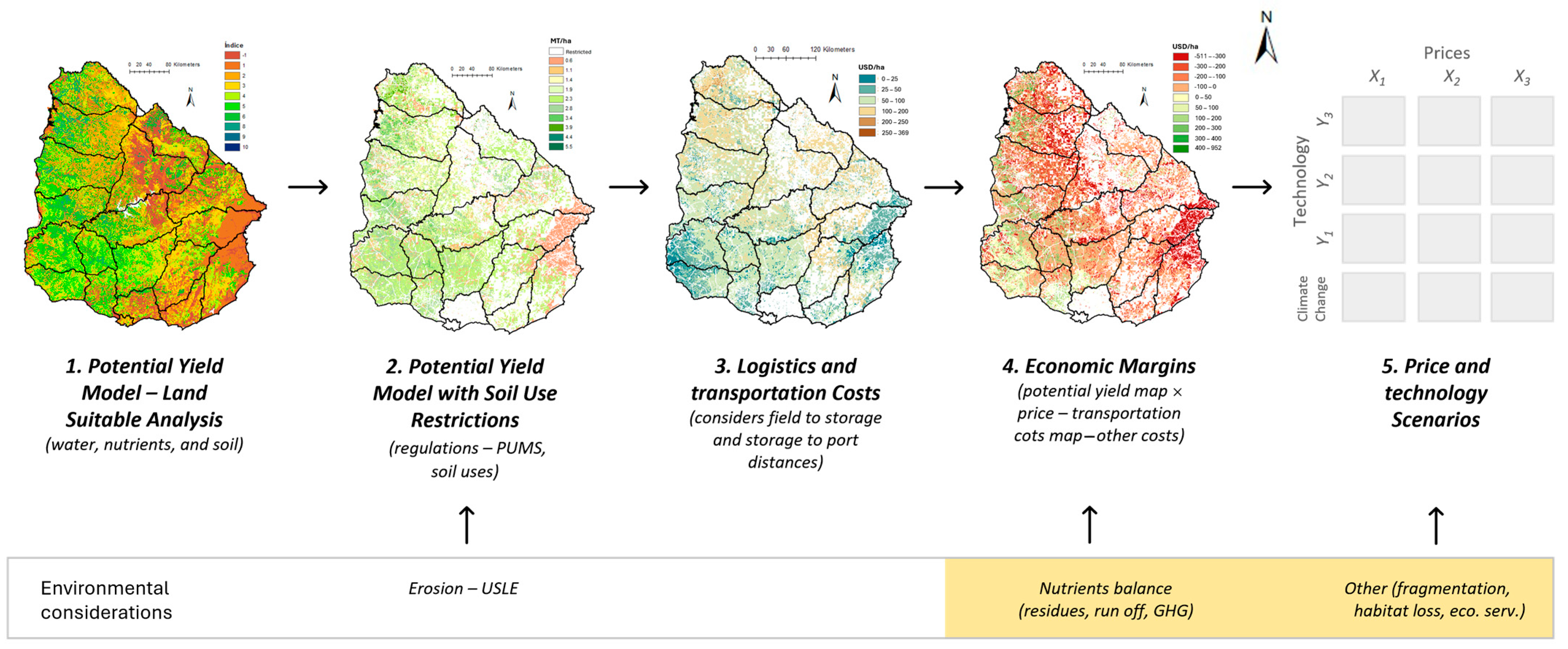
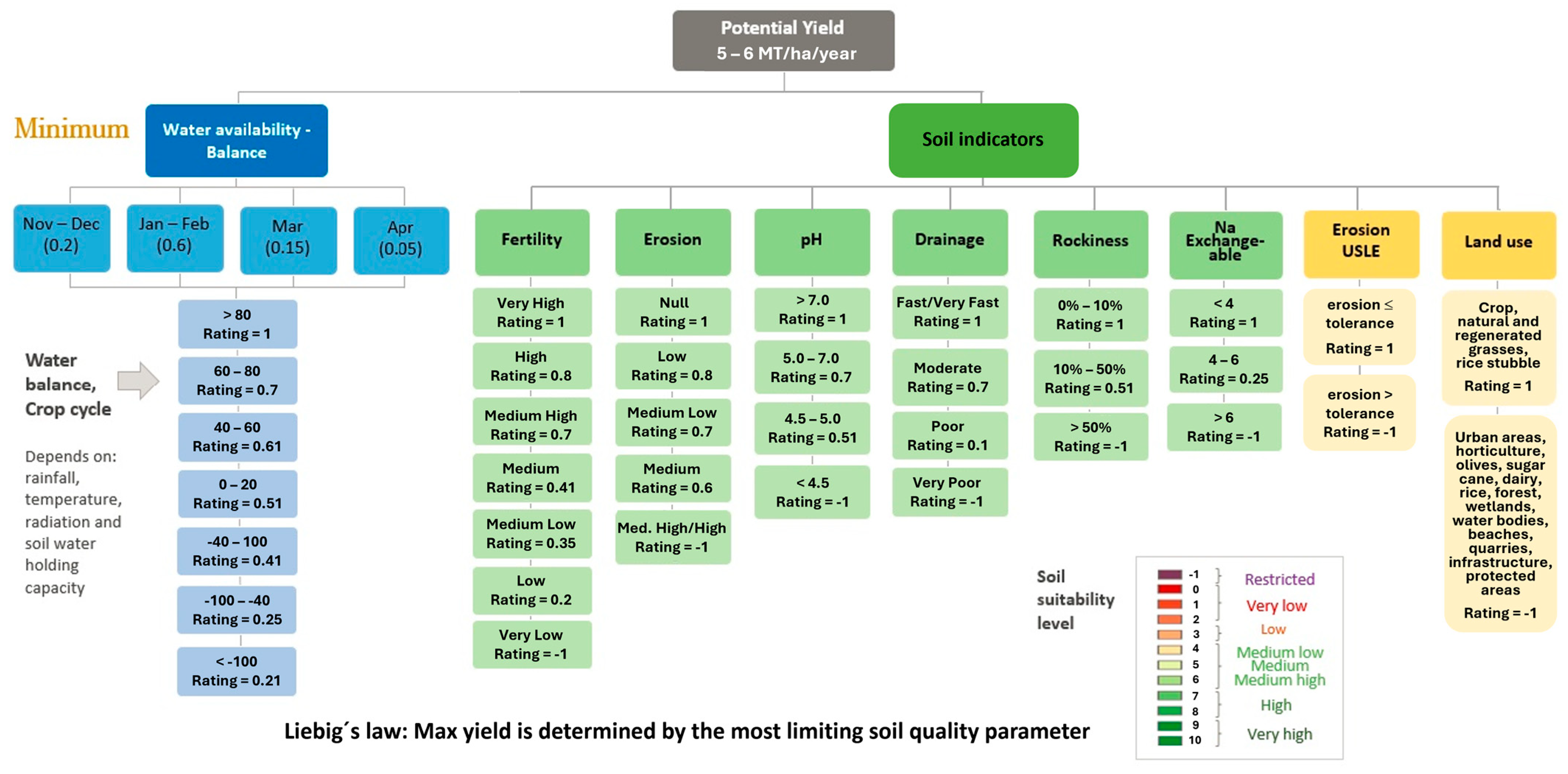
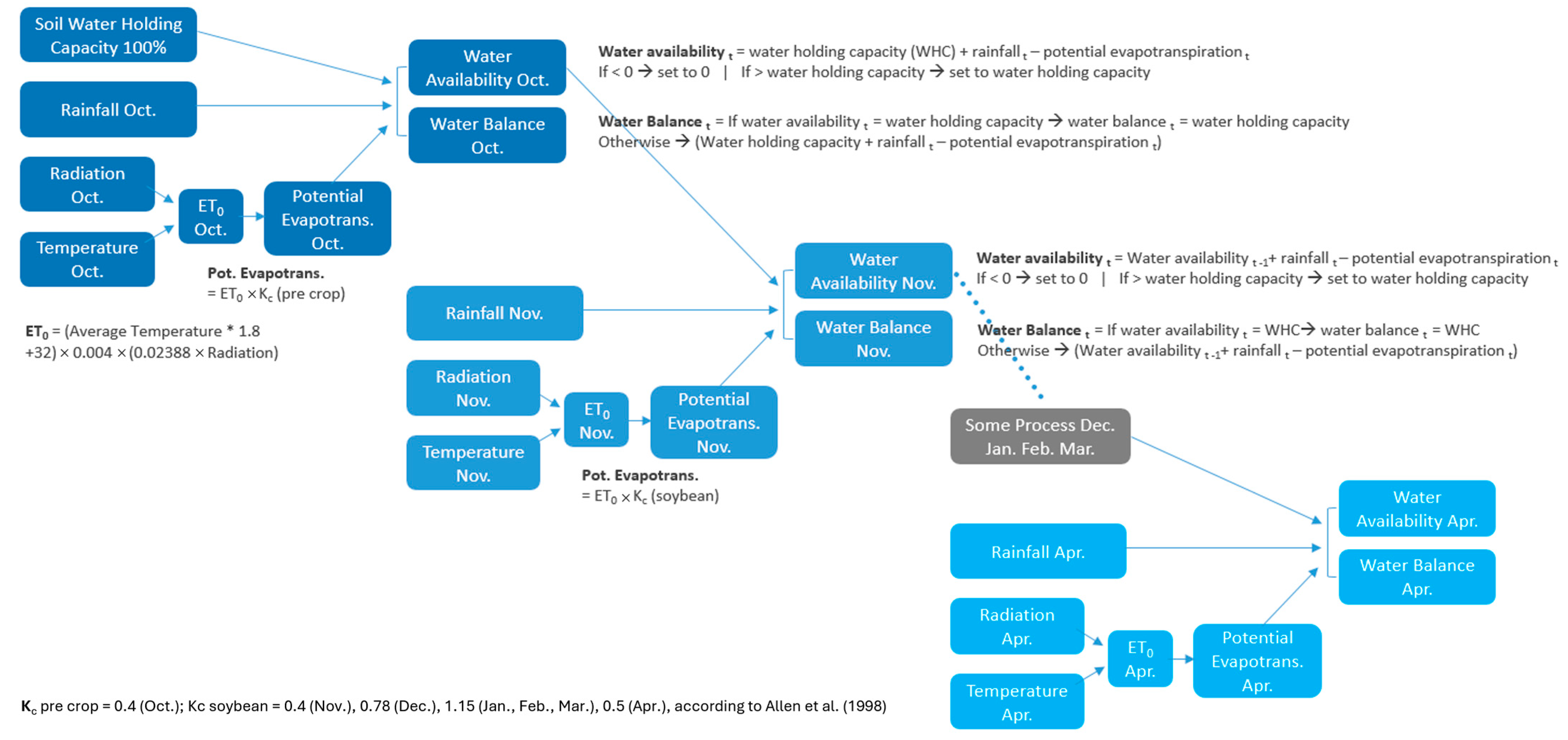
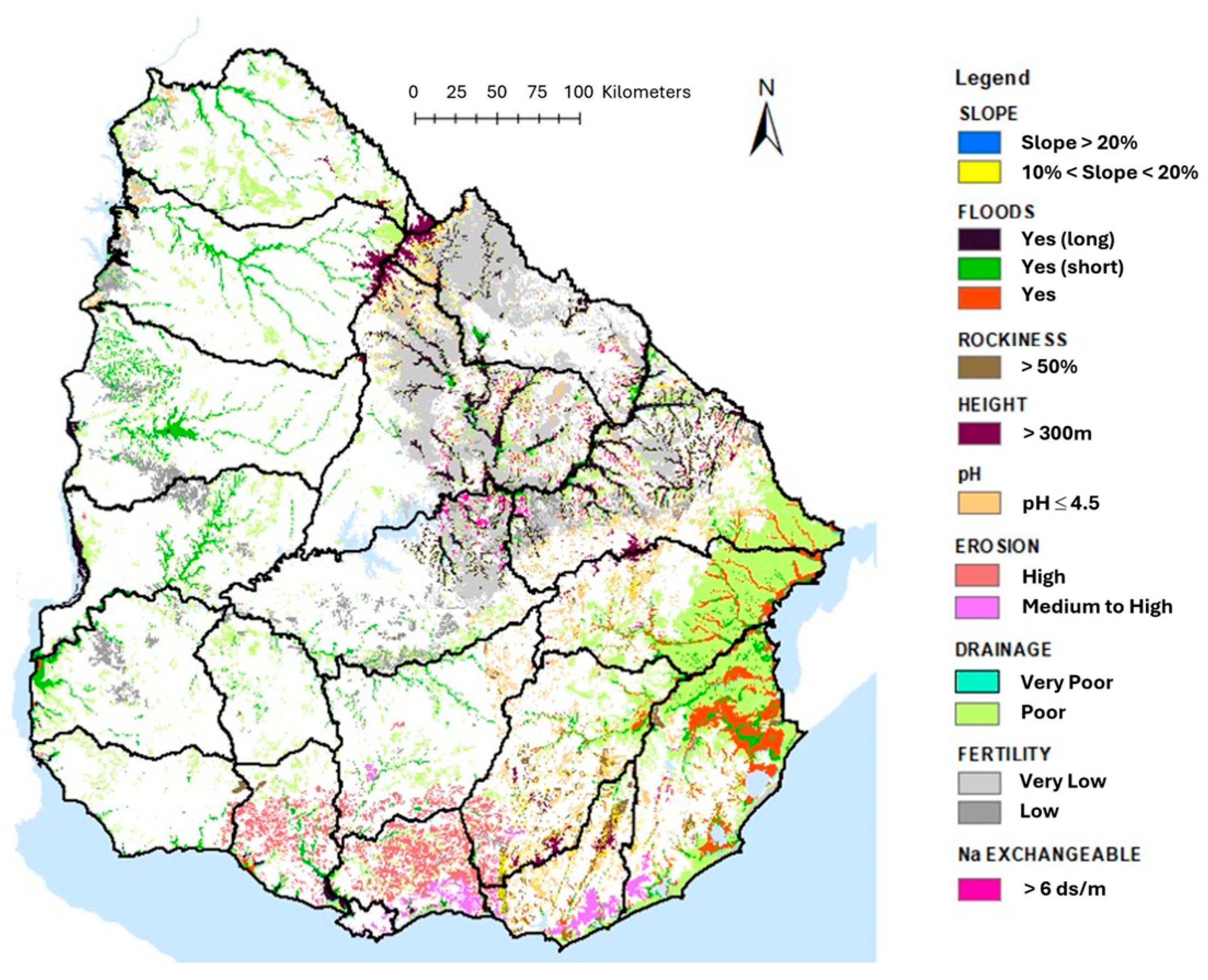
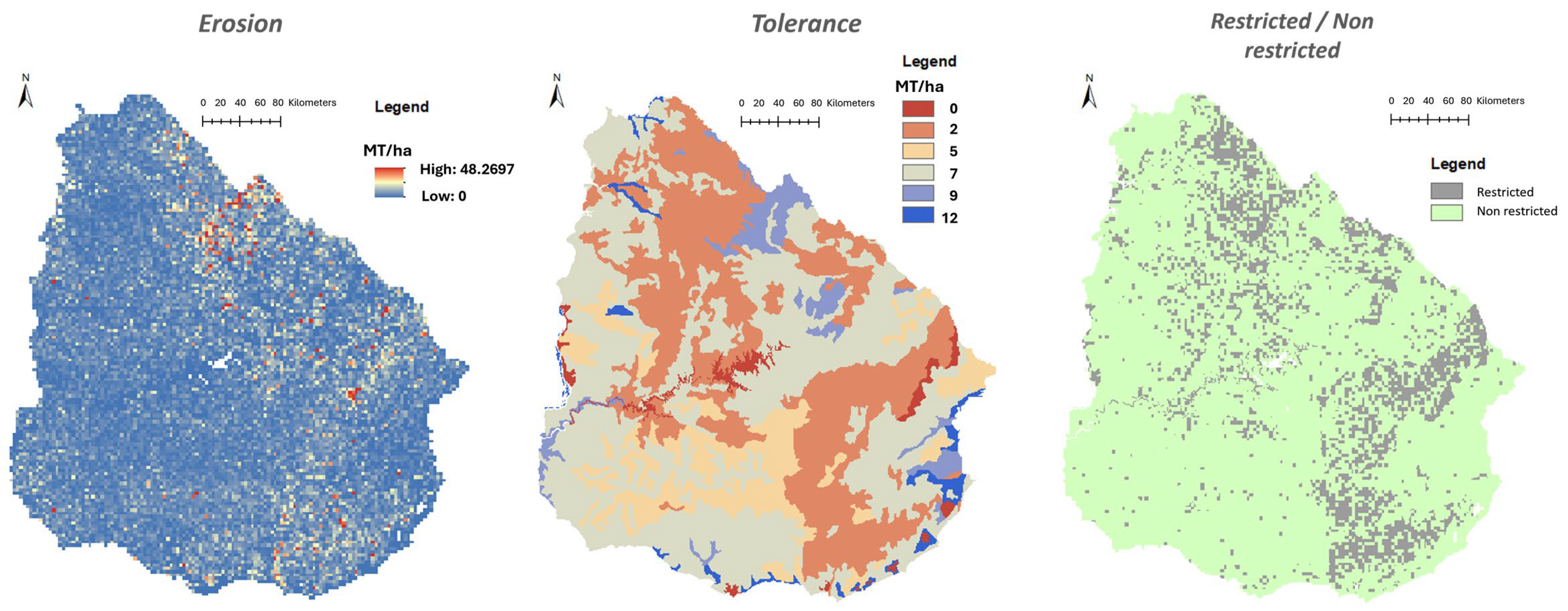
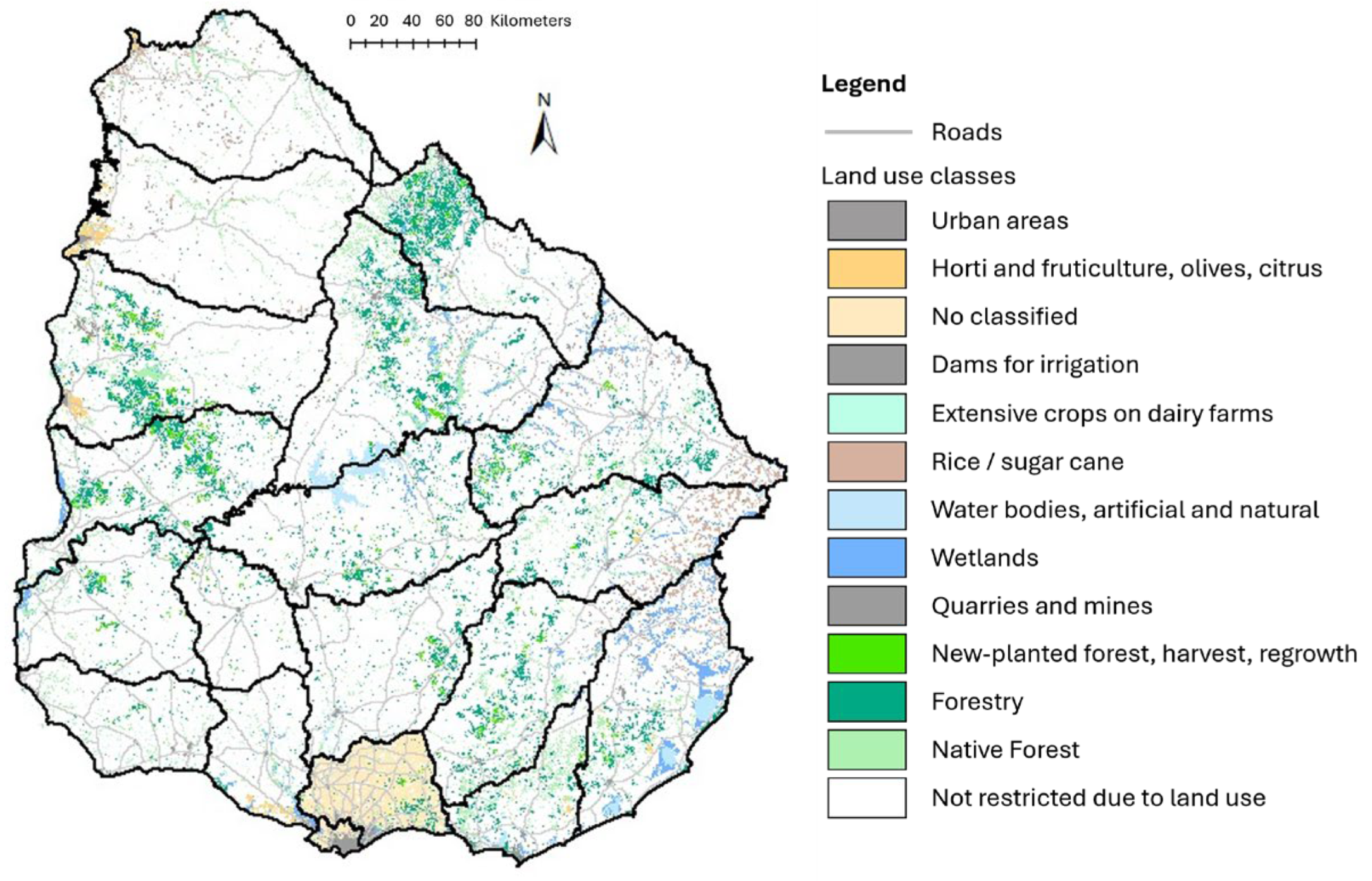
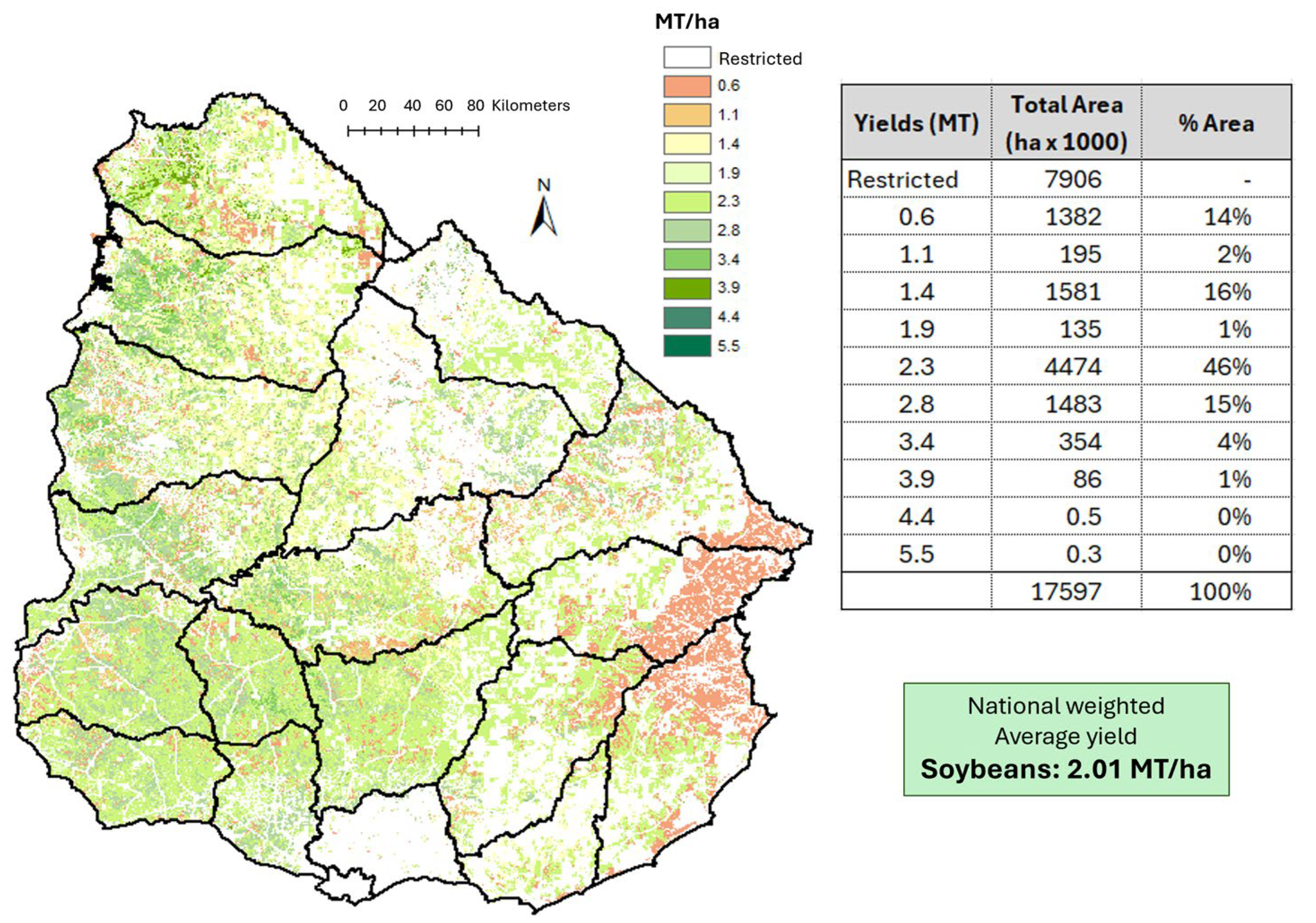
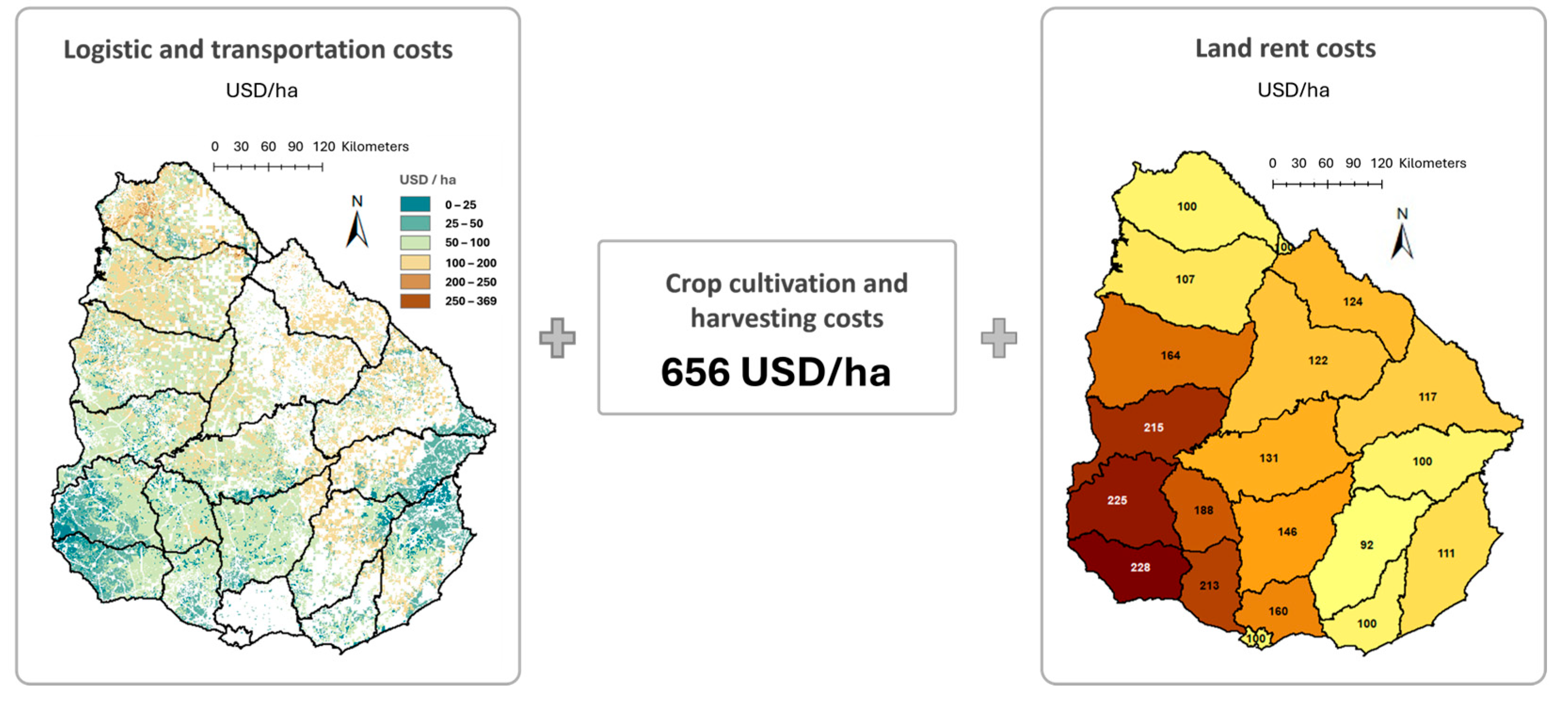
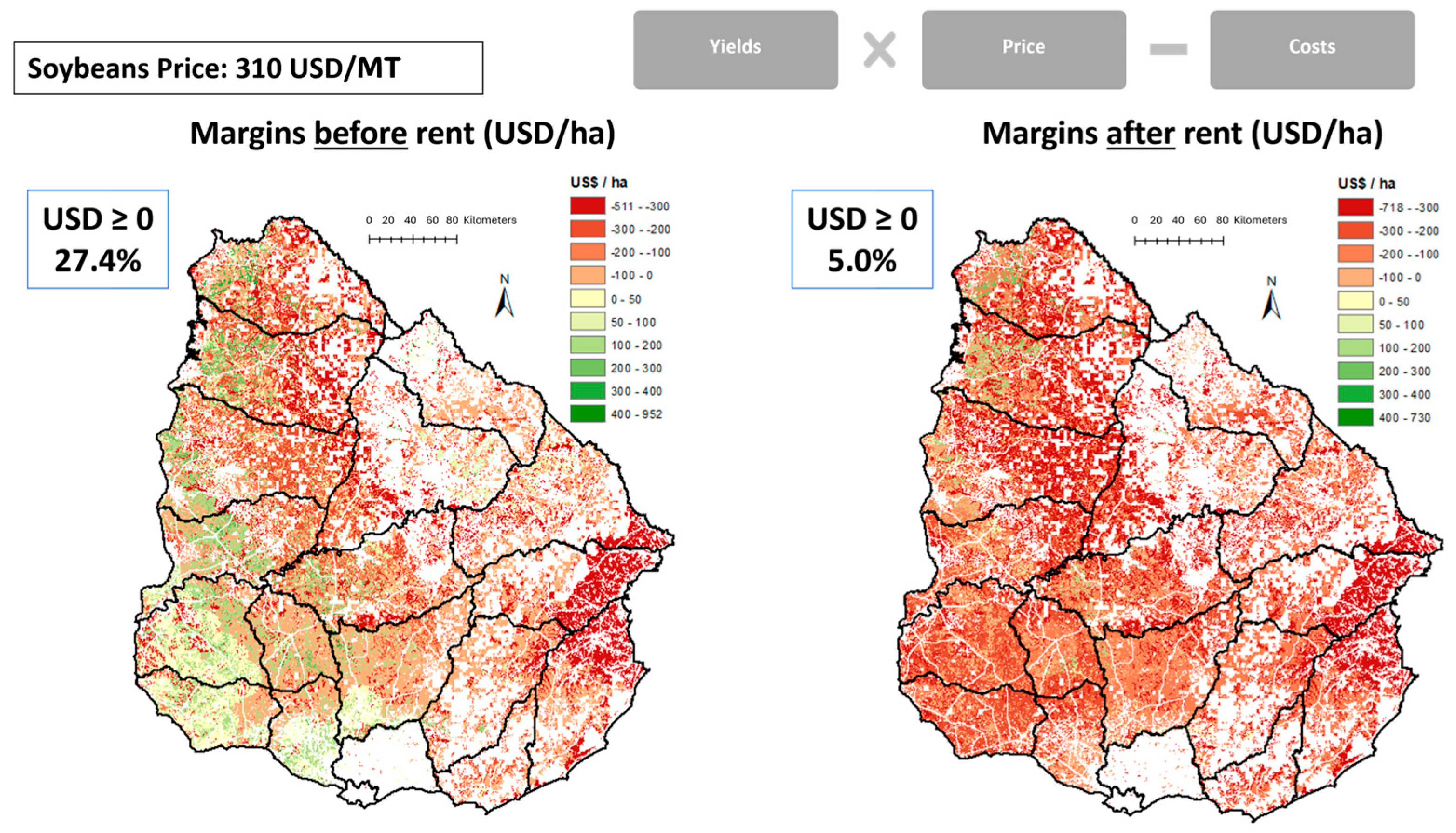
| Country/Region | Quantity | Monetary Value | Ranking 1 | ||
|---|---|---|---|---|---|
| Metric Tons | % | USD × 1000 | % | ||
| Brazil | 88,970,602 | 54.2 | 46,182,561 | 52.3 | 1st |
| United States | 53,033,751 | 32.3 | 30,006,358 | 34.0 | 2nd |
| Canada | 4,419,149 | 2.7 | 2,596,317 | 2.9 | 3rd |
| Paraguay | 5,032,349 | 3.1 | 2,541,975 | 2.9 | 4th |
| Argentina | 3,777,802 | 2.3 | 2,112,635 | 2.4 | 5th |
| Uruguay | 1,869,652 | 1.1 | 1,077,851 | 1.2 | 6th |
| Ukraine | 2,211,821 | 1.3 | 922,664 | 1.0 | 7th |
| Americas, all | 157,493,302 | 96.0 | 84,730,112 | 95.9 | --- |
| World total | 164,080,587 | 100.0 | 88,352,456 | 100.0 | --- |
| Tech. Change | Variable 2 | USD/MT 310 | USD/MT 350 | USD/MT 400 | |||
|---|---|---|---|---|---|---|---|
| No Rent | Full Rent | No Rent | Full Rent | No Rent | Full Rent | ||
| No | Area | 2.65 | 0.49 | 6.37 | 1.89 | 6.53 | 5.26 |
| Yield | 2.78 | 3.43 | 2.50 | 2.96 | 2.49 | 2.54 | |
| Prod. | 7.4 | 1.7 | 15.9 | 5.6 | 16.2 | 13.4 | |
| Yes 1 | Area | 6.46 | 3.41 | 6.53 | 6.39 | 6.59 | 6.53 |
| Yield | 3.17 | 3.39 | 3.16 | 3.17 | 3.14 | 3.16 | |
| Prod. | 20.4 | 11.6 | 20.6 | 20.3 | 20.7 | 20.6 | |
| Variables | Soybean Included in a Rotation 1 | ||
|---|---|---|---|
| No Rent | Full Rent | Land Ownership 2 | |
| Area (million hectares) | 2.85 | 1.63 | 2.1 |
| Yields (tons per hectare) | 3.17 | 3.39 | 3.3 |
| Production (million tons) | 9.2 | 5.4 | 6.9 |
| Technology | No Technological Change | With Technological Change | ||||
|---|---|---|---|---|---|---|
| Price level | USD 310/MT | USD 310/MT | ||||
| Rent 2 | No | Full | Weighted | No | Full | Weighted |
| Monocrop | 2.65 | 0.49 | 1.35 | 6.46 | 3.41 | 4.63 |
| Rotation 1 | 1.33 | 0.67 | 0.93 | 2.85 | 1.63 | 2.12 |
| Price level | USD 350/MT | USD 350/MT | ||||
| Rent 2 | No | Full | Weighted | No | Full | Weighted |
| Monocrop | 6.37 | 1.89 | 3.68 | 6.53 | 6.39 | 6.45 |
| Rotation 1 | 2.82 | 1.03 | 1.74 | 2.88 | 2.83 | 2.85 |
| Price level | USD 400/MT | USD 400/MT | ||||
| Rent 2 | No | Full | Weighted | No | Full | Weighted |
| Monocrop | 6.53 | 5.26 | 5.77 | 6.59 | 6.53 | 6.55 |
| Rotation 1 | 2.88 | 2.37 | 2.58 | 2.91 | 2.88 | 2.89 |
| Climate Change | Variable 3 | USD 310/MT | USD 350/MT | USD 400/MT | |||
|---|---|---|---|---|---|---|---|
| No Rent | Full Rent | No Rent | Full Rent | No Rent | Full Rent | ||
| No 1 | Area | 2.65 | 0.49 | 6.37 | 1.89 | 6.53 | 5.26 |
| Yield | 2.78 | 3.43 | 2.50 | 2.96 | 2.49 | 2.54 | |
| Prod. | 7.4 | 1.7 | 15.9 | 5.6 | 16.2 | 13.4 | |
| Yes 2 | Area | 2.68 | 0.50 | 6.21 | 1.92 | 6.36 | 5.09 |
| Yield | 2.77 | 3.36 | 2.50 | 2.95 | 2.49 | 2.55 | |
| Prod. | 7.4 | 1.7 | 15.6 | 5.6 | 15.8 | 13.0 | |
Disclaimer/Publisher’s Note: The statements, opinions and data contained in all publications are solely those of the individual author(s) and contributor(s) and not of MDPI and/or the editor(s). MDPI and/or the editor(s) disclaim responsibility for any injury to people or property resulting from any ideas, methods, instructions or products referred to in the content. |
© 2025 by the authors. Licensee MDPI, Basel, Switzerland. This article is an open access article distributed under the terms and conditions of the Creative Commons Attribution (CC BY) license (https://creativecommons.org/licenses/by/4.0/).
Share and Cite
Lanfranco, B.A.; Borges, M.; Fernández, E.G.; Rava, C.; Ferraro, B. Assessing the Limits of Sustainable Agriculture Intensification Using a Spatial Model Framework. Sustainability 2025, 17, 7304. https://doi.org/10.3390/su17167304
Lanfranco BA, Borges M, Fernández EG, Rava C, Ferraro B. Assessing the Limits of Sustainable Agriculture Intensification Using a Spatial Model Framework. Sustainability. 2025; 17(16):7304. https://doi.org/10.3390/su17167304
Chicago/Turabian StyleLanfranco, Bruno A., Magdalena Borges, Enrique G. Fernández, Catalina Rava, and Bruno Ferraro. 2025. "Assessing the Limits of Sustainable Agriculture Intensification Using a Spatial Model Framework" Sustainability 17, no. 16: 7304. https://doi.org/10.3390/su17167304
APA StyleLanfranco, B. A., Borges, M., Fernández, E. G., Rava, C., & Ferraro, B. (2025). Assessing the Limits of Sustainable Agriculture Intensification Using a Spatial Model Framework. Sustainability, 17(16), 7304. https://doi.org/10.3390/su17167304







